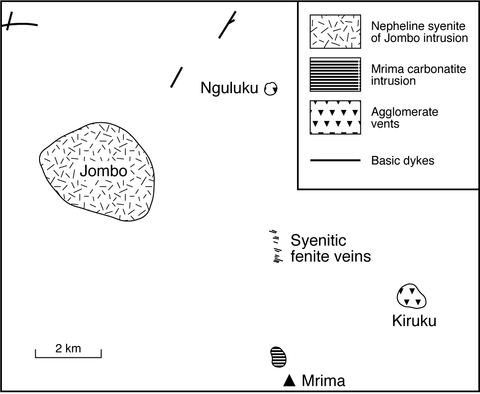stripes
Jombo is an approximately circular 3 km diameter intrusion of nepheline syenites to the northeast, east and southeast of which are the carbonatitic vents of Mrima, Nguluku and Kiruku and. There are also a range of associated dykes up to 20 km from Jombo making this a small, discrete province isolated spatially and temporally from the rest of the alkaline igneous activity of Kenya (Baker, 1953). The approximately circular Jombo intrusion is heavily forested making mapping difficult (Baker, 1953). Baker indicates the presence of an outer zone of microfoyaite and micromelteigite passing inwards to foyaites. In the southern half of the intrusion is a large body of melteigite, grading in places into ijolite and malignite, which is cut by nepheline syenites that occupy the summit of the hill. A somewhat different configuration of the intrusion is given by Nyambok (1980, Fig. 2), but his subdivisions are rather unusual in so far as his micromelteigite contains 10% albite, 2% nepheline, 24% sodalite/ analcime and has a colour index of 64, while modes of ijolites include 18% and 15% albite. The following brief description is based on Baker (1953). The microfoyaite of the outer zone consists of perthite and nepheline, with pyroxene forming interstitial areas and larger grains zoned from diopsidic cores to aegirine-augite rims; small aegirine grains are enclosed in feldspar. The micromelteigite consists of about 50% aegirine-augite, some 30% nepheline and abundant titanite and barkevikitic amphibole; it is free of feldspar. The main foyaites are coarse rocks with aligned phenocrysts of orthoclase or perthite up to 3 cm in length, euhedral nepheline, acicular aegirine and aegirine-augite, titanite, and in some varieties abundant sodalite and rare biotite. The melteigites are veined and partly replaced by leucocratic syenite. They all contain abundant pyroxene but varieties with 40% barkevikitic amphibole, with or without biotite, or up to 20% biotite also occur; melanite is present in some variants. These rocks grade, with increase in nepheline, which may be replaced by sodalite, into ijolites. The summit nepheline syenites contain aegirine-augite and aegirine. Dykes have been found over the southern part of the area up to 20 km from Jombo. They are principally lamprophyres but phonolites are also represented (Baker, 1953). The Kikonde ridge, 3 km east-southeast of Jombo, is built of feldspathic sandstones that are cut by numerous syenitic veins, rarely exceeding 4 cm in width, that strike towards Jombo Hill. The veins vary from narrow ones composed solely of aegirine to broader types in which the aegirine forms a rim to a core of K-feldspar. The sandstone adjacent to the veins is fenitised, the quartz grains being wholly or partly replaced by orthoclase, albite and aegirine (Baker, 1953). Whole rock analyses, including some trace elements, of a range of Jombo rocks are given by Nyambok (1980) and Sr isotopic data will be found in Rock (1976b). A detailed gravity and aeromagnetic investigation was made by Dindi and Swain (1988). Mrima is a carbonatite intrusion that forms a low hill some 2 km long. Outcrop is poor the hill being draped in laterite which in several central areas is over 100 m thick. Trenching, pitting and drilling (Coetzee and Edwards, 1960) has shown the intrusion to consist of carbonatite, lamprophyre and fenitized Karoo sediments. The carbonatites are subdivided by Coetzee and Edwards (1960) into sovite, biotite carbonatite, dolomitic carbonatite and carbonatite agglomerate. Sovite is the most abundant rock type and is a variably coarse- or medium-grained calcite rock with accessory amphibole, biotite, pyrite, pyrochlore and fluorite. Within the sovite in places are angular and rounded fragments of biotite-rich carbonatite in which dolomite is much more abundant than calcite. The dolomite carbonatite is a dark brown rock encountered in some shafts and boreholes which contains up to 70% dolomite and accessory pyrite, chlorite and pyrochlore. The carbonatite agglomerate is confined to outcrops on the southwestern slope of the hill, and consists of fragments of sedimentary rocks and crystals of biotite, hornblende, aegirine-augite and microcline in a calcite-rich matrix. The lamprophyres occur as fragments within the carbonatite and as dykes and include camptonite, with augite phenocrysts in a matrix of feldspar, pyroxene, magnetite and carbonate, and rocks described as monchiquite consisting of pyroxene and olivine phenocrysts in a matrix of glass and small pyroxenes. Fenitization of the arenaceous sedimentary rocks around the intrusion has produced a narrow aureole in which orthoclase and aegirine-augite are developed. Coetzee and Edwards (1960) give a detailed account of the mineralogy and chemistry of the laterite cover at Mrima. The Nguluku vent is some 350 m across and consists of fragments of sedimentary rocks in a matrix of calcite, quartz and limonite with plentiful apatite. The Kiruku vent is a little larger than Nguluku and consists solely of sandstone fragments in a very fine-grained quartz matrix.
BAKER, B.H. (in CASWELL, P.V. and BAKER, B.H.) 1953. Geology of the Mombasa-Kwale area. Report, Geological Survey of Kenya, 24: 1-69.COETZEE, G.L. and EDWARDS, C.B. 1960. The Mrima Hill carbonatite, Coast Province, Kenya. Transactions of the Geological Society of South Africa, 62: 373-97. DINDI, E.W. and SWAIN, C.J. 1988. Joint three-dimensional inversion of gravity and magnetic data from Jombo Hill alkaline complex, Kenya. Journal of the Geological Society of London, 145: 493-504. Hayward, pers. comm., 1999.NYAMBOK, I.O. 1980. Petrology and geochemistry of the alkaline intrusion, Jombo Hill, Kenya. Geological Magazine, 117: 327-38.ROCK, N.M.S. 1976b. A comparative strontium isotopic composition of alkaline rocks: new data from southern Portugal and East Africa. Contributions to Mineralogy and Petrology, 56: 205-28.

